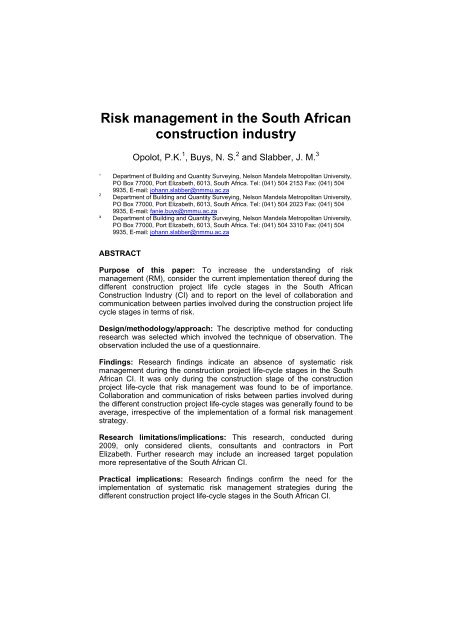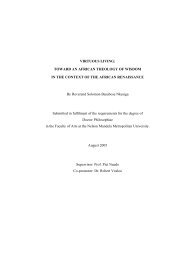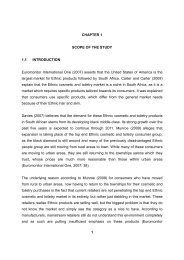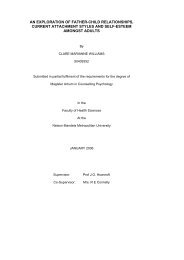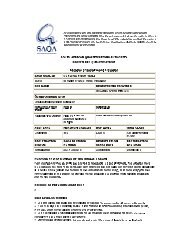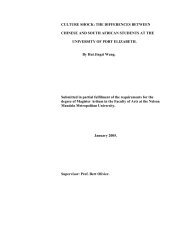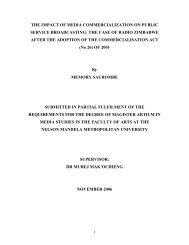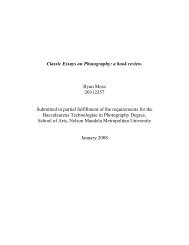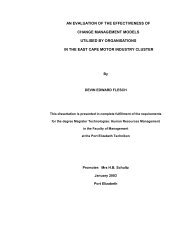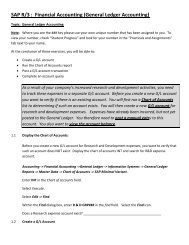Risk management in the South African construction industry
Risk management in the South African construction industry
Risk management in the South African construction industry
Create successful ePaper yourself
Turn your PDF publications into a flip-book with our unique Google optimized e-Paper software.
<strong>Risk</strong> <strong>management</strong> <strong>in</strong> <strong>the</strong> <strong>South</strong> <strong>African</strong><br />
<strong>construction</strong> <strong>in</strong>dustry<br />
Opolot, P.K. 1 , Buys, N. S. 2 and Slabber, J. M. 3<br />
1 Department of Build<strong>in</strong>g and Quantity Survey<strong>in</strong>g, Nelson Mandela Metropolitan University,<br />
PO Box 77000, Port Elizabeth, 6013, <strong>South</strong> Africa. Tel: (041) 504 2153 Fax: (041) 504<br />
9935, E-mail: johann.slabber@nmmu.ac.za<br />
2 Department of Build<strong>in</strong>g and Quantity Survey<strong>in</strong>g, Nelson Mandela Metropolitan University,<br />
PO Box 77000, Port Elizabeth, 6013, <strong>South</strong> Africa. Tel: (041) 504 2023 Fax: (041) 504<br />
9935, E-mail: fanie.buys@nmmu.ac.za<br />
³ Department of Build<strong>in</strong>g and Quantity Survey<strong>in</strong>g, Nelson Mandela Metropolitan University,<br />
PO Box 77000, Port Elizabeth, 6013, <strong>South</strong> Africa. Tel: (041) 504 3310 Fax: (041) 504<br />
9935, E-mail: johann.slabber@nmmu.ac.za<br />
ABSTRACT<br />
Purpose of this paper: To <strong>in</strong>crease <strong>the</strong> understand<strong>in</strong>g of risk<br />
<strong>management</strong> (RM), consider <strong>the</strong> current implementation <strong>the</strong>reof dur<strong>in</strong>g <strong>the</strong><br />
different <strong>construction</strong> project life cycle stages <strong>in</strong> <strong>the</strong> <strong>South</strong> <strong>African</strong><br />
Construction Industry (CI) and to report on <strong>the</strong> level of collaboration and<br />
communication between parties <strong>in</strong>volved dur<strong>in</strong>g <strong>the</strong> <strong>construction</strong> project life<br />
cycle stages <strong>in</strong> terms of risk.<br />
Design/methodology/approach: The descriptive method for conduct<strong>in</strong>g<br />
research was selected which <strong>in</strong>volved <strong>the</strong> technique of observation. The<br />
observation <strong>in</strong>cluded <strong>the</strong> use of a questionnaire.<br />
F<strong>in</strong>d<strong>in</strong>gs: Research f<strong>in</strong>d<strong>in</strong>gs <strong>in</strong>dicate an absence of systematic risk<br />
<strong>management</strong> dur<strong>in</strong>g <strong>the</strong> <strong>construction</strong> project life-cycle stages <strong>in</strong> <strong>the</strong> <strong>South</strong><br />
<strong>African</strong> CI. It was only dur<strong>in</strong>g <strong>the</strong> <strong>construction</strong> stage of <strong>the</strong> <strong>construction</strong><br />
project life-cycle that risk <strong>management</strong> was found to be of importance.<br />
Collaboration and communication of risks between parties <strong>in</strong>volved dur<strong>in</strong>g<br />
<strong>the</strong> different <strong>construction</strong> project life-cycle stages was generally found to be<br />
average, irrespective of <strong>the</strong> implementation of a formal risk <strong>management</strong><br />
strategy.<br />
Research limitations/implications: This research, conducted dur<strong>in</strong>g<br />
2009, only considered clients, consultants and contractors <strong>in</strong> Port<br />
Elizabeth. Fur<strong>the</strong>r research may <strong>in</strong>clude an <strong>in</strong>creased target population<br />
more representative of <strong>the</strong> <strong>South</strong> <strong>African</strong> CI.<br />
Practical implications: Research f<strong>in</strong>d<strong>in</strong>gs confirm <strong>the</strong> need for <strong>the</strong><br />
implementation of systematic risk <strong>management</strong> strategies dur<strong>in</strong>g <strong>the</strong><br />
different <strong>construction</strong> project life-cycle stages <strong>in</strong> <strong>the</strong> <strong>South</strong> <strong>African</strong> CI.
2 <strong>Risk</strong> <strong>management</strong> <strong>in</strong> <strong>the</strong> <strong>South</strong> <strong>African</strong> <strong>construction</strong> <strong>in</strong>dustry<br />
Orig<strong>in</strong>al/value: The <strong>South</strong> <strong>African</strong> CI can only benefit from this research as<br />
emphasis is placed on creat<strong>in</strong>g an understand<strong>in</strong>g of <strong>the</strong> importance of<br />
implement<strong>in</strong>g an effective risk <strong>management</strong> strategy throughout <strong>the</strong><br />
different stages of <strong>the</strong> <strong>construction</strong> project life cycle <strong>in</strong> <strong>the</strong> <strong>South</strong> <strong>African</strong> CI.<br />
An effective risk <strong>management</strong> strategy will fur<strong>the</strong>r improve communication<br />
among <strong>the</strong> various parties to <strong>construction</strong> projects. This should facilitate <strong>the</strong><br />
decision mak<strong>in</strong>g process <strong>in</strong> <strong>the</strong> event of hav<strong>in</strong>g to deal with specific risks.<br />
KEYWORDS: Collaboration, Communication, Implementation, <strong>Risk</strong><br />
Management.<br />
1. INTRODUCTION<br />
The CI is subject to more risk and uncerta<strong>in</strong>ty than perhaps any o<strong>the</strong>r<br />
<strong>in</strong>dustry. Yet, surpris<strong>in</strong>gly, managerial techniques used to identify, analyse<br />
and respond to risks were not applied <strong>in</strong> <strong>the</strong> <strong>in</strong>dustry until well <strong>in</strong>to <strong>the</strong><br />
1980s. The procedure of tak<strong>in</strong>g a project from <strong>in</strong>ception to completion, and<br />
<strong>the</strong>n <strong>in</strong>to use is a complex one that entails time-consum<strong>in</strong>g design and<br />
production processes (Ahmed & Azhar, 2004).<br />
Some of <strong>the</strong> risks associated with <strong>construction</strong> are poor quality of<br />
work, premature failure of <strong>the</strong> facility, a lack of safety, poor or <strong>in</strong>correct<br />
design, and f<strong>in</strong>ancial risks (Mahesh & Kumaraswamy, 2007). Edwards and<br />
Bowen (2005) have identified RM as an important tool <strong>in</strong> deal<strong>in</strong>g with and<br />
overcom<strong>in</strong>g some of <strong>the</strong> above risks on a <strong>construction</strong> project.<br />
Accord<strong>in</strong>g to Mills (2001), RM plays a significant role <strong>in</strong> <strong>the</strong> decisionmak<strong>in</strong>g<br />
process. It can affect productivity, performance, quality and <strong>the</strong><br />
budget on a <strong>construction</strong> project. The purpose of RM is to ensure that all<br />
parties to a <strong>construction</strong> project understand <strong>the</strong> risks specific to <strong>the</strong> project<br />
and reach agreement on how <strong>the</strong>se risks should be managed.<br />
2. RISK MANAGEMENT<br />
Several def<strong>in</strong>itions of risk exist <strong>in</strong> <strong>the</strong> literature.<br />
Accord<strong>in</strong>g to <strong>the</strong> Oxford English Dictionary (2009), risk is a situation<br />
<strong>in</strong>volv<strong>in</strong>g exposure to danger or <strong>the</strong> possibility that someth<strong>in</strong>g unpleasant<br />
will happen. Edwards and Bowen (2005) def<strong>in</strong>e risk as <strong>the</strong> probability that<br />
an adverse event will occur dur<strong>in</strong>g a stated period of time. The Project<br />
Management Body of Knowledge (PMBOK) (2000) def<strong>in</strong>es risk as <strong>the</strong><br />
comb<strong>in</strong>ed likelihood that an event will occur and <strong>the</strong> impact <strong>the</strong>reof on <strong>the</strong><br />
project, if <strong>the</strong> event does occur.<br />
Accord<strong>in</strong>g to Bower (2009), RM is <strong>the</strong> sum of all proactive<br />
<strong>management</strong>-directed activities with<strong>in</strong> a programme that are <strong>in</strong>tended to<br />
acceptably accommodate <strong>the</strong> possibility of failure <strong>in</strong> <strong>the</strong> elements of a<br />
programme; whereas Van Well-Stam, L<strong>in</strong>denaa, Van K<strong>in</strong>deren & Van den<br />
Bunt (2004) def<strong>in</strong>e RM as <strong>the</strong> entire set of activities and measures that are
<strong>Risk</strong> <strong>management</strong> <strong>in</strong> <strong>the</strong> <strong>South</strong> <strong>African</strong> <strong>construction</strong> <strong>in</strong>dustry 3<br />
aimed at deal<strong>in</strong>g with any possible risks, <strong>in</strong> order to ma<strong>in</strong>ta<strong>in</strong> control over a<br />
project; and PMBOK (2000) def<strong>in</strong>es RM as <strong>the</strong> systematic process of<br />
identify<strong>in</strong>g, analyz<strong>in</strong>g and respond<strong>in</strong>g to risk.<br />
For <strong>the</strong> purpose of <strong>the</strong> research, <strong>the</strong> def<strong>in</strong>ition of risk was limited to<br />
<strong>the</strong> one that has a negative impact on a project; and hence <strong>the</strong> def<strong>in</strong>ition of<br />
RM is limited to <strong>the</strong> process of deal<strong>in</strong>g with adverse risks, as <strong>the</strong>se pose<br />
hurdles to reach<strong>in</strong>g any agreement on <strong>the</strong> shar<strong>in</strong>g of strategies and<br />
mechanisms <strong>in</strong> <strong>the</strong> CI.<br />
Accord<strong>in</strong>g to <strong>the</strong> def<strong>in</strong>ition of RM by PMBOK (2000), it is evident that <strong>the</strong><br />
RM process <strong>in</strong>volves three steps, namely: identify<strong>in</strong>g, analys<strong>in</strong>g and<br />
respond<strong>in</strong>g. This def<strong>in</strong>ition however, does not provide a detailed and<br />
substantial picture of <strong>the</strong> steps <strong>in</strong>volved, as it consists of a number of subprocesses,<br />
which <strong>in</strong> <strong>the</strong>mselves can be viewed as steps.<br />
For <strong>the</strong> purpose of <strong>the</strong> research, a simplified RM process of five<br />
steps was used. This process, accord<strong>in</strong>g to Rahman (2003), <strong>in</strong>cluded:<br />
<strong>Risk</strong> Identification: The process of systematically identify<strong>in</strong>g,<br />
categoris<strong>in</strong>g and assess<strong>in</strong>g <strong>the</strong> <strong>in</strong>itial significance of <strong>the</strong> risks<br />
associated with a <strong>construction</strong> project and document<strong>in</strong>g <strong>the</strong>ir<br />
characteristics;<br />
<strong>Risk</strong> Analysis: The consideration of <strong>the</strong> sources of different risks; <strong>the</strong><br />
consequences associated with each type of risk or comb<strong>in</strong>ation of<br />
risks, and an assessment of <strong>the</strong> impact of such risks by various riskmeasurement<br />
techniques;<br />
<strong>Risk</strong> Evaluation: The process of compar<strong>in</strong>g <strong>the</strong> level of risk found<br />
dur<strong>in</strong>g <strong>the</strong> analysis process by means of previously established criteria;<br />
<strong>Risk</strong> Response: The process of identify<strong>in</strong>g/develop<strong>in</strong>g risk-response<br />
options and determ<strong>in</strong><strong>in</strong>g actions for treat<strong>in</strong>g <strong>the</strong> risk, target<strong>in</strong>g<br />
enhanc<strong>in</strong>g opportunities and reduc<strong>in</strong>g any threats to project objectives;<br />
and<br />
<strong>Risk</strong> monitor<strong>in</strong>g: The process of keep<strong>in</strong>g track of <strong>the</strong> identified risks,<br />
monitor<strong>in</strong>g residual risks, identify<strong>in</strong>g new risks, ensur<strong>in</strong>g <strong>the</strong> execution<br />
of risk-reduction plans, and evaluat<strong>in</strong>g <strong>the</strong> effectiveness <strong>in</strong> reduc<strong>in</strong>g<br />
risk with respect to chang<strong>in</strong>g circumstances.<br />
The <strong>construction</strong> process can be divided <strong>in</strong>to five ma<strong>in</strong> stages (Table 1,<br />
page 4), but for <strong>the</strong> purpose of this research, only <strong>the</strong> first four stages will<br />
be considered, as it is assumed that RM is limited dur<strong>in</strong>g <strong>the</strong> f<strong>in</strong>al stage.
4 <strong>Risk</strong> <strong>management</strong> <strong>in</strong> <strong>the</strong> <strong>South</strong> <strong>African</strong> <strong>construction</strong> <strong>in</strong>dustry<br />
Table 1 The <strong>construction</strong> process<br />
INCEPTION Appraisal<br />
Client’s needs and objectives are identified;<br />
Bus<strong>in</strong>ess case and possible constra<strong>in</strong>ts on development<br />
are identified;<br />
Preparation of feasibility studies and assessment of<br />
options to enable <strong>the</strong> client to decide whe<strong>the</strong>r to proceed.<br />
Design brief<br />
Development of <strong>in</strong>itial statement of requirements <strong>in</strong>to <strong>the</strong><br />
design brief or on behalf of <strong>the</strong> client, confirm<strong>in</strong>g key<br />
requirements and constra<strong>in</strong>ts;<br />
Identification of procurement method, procedures,<br />
organisational structure and range of consultants and<br />
o<strong>the</strong>rs to be engaged for <strong>the</strong> project.<br />
DESIGN Concept<br />
Implementation of design brief and preparation of<br />
additional data;<br />
Preparation of concept design <strong>in</strong>clud<strong>in</strong>g outl<strong>in</strong>ed<br />
proposals for structural and build<strong>in</strong>g service systems,<br />
outl<strong>in</strong>e specifications and prelim<strong>in</strong>ary cost plan;<br />
Review of procurement process.<br />
Design development<br />
Development of concept design, <strong>in</strong>clud<strong>in</strong>g structural and<br />
build<strong>in</strong>g service systems, updated outl<strong>in</strong>ed specifications<br />
and cost plan;<br />
Completion of project brief.<br />
Technical design<br />
Preparation of technical design(s) and specifications,<br />
sufficient to co-ord<strong>in</strong>ate components and elements of <strong>the</strong><br />
PRE-<br />
CONSTRUCTION<br />
project.<br />
Production <strong>in</strong>formation<br />
Preparation of detailed <strong>in</strong>formation for <strong>construction</strong>.<br />
Tender documentation<br />
Preparation of tender documentation.<br />
Tender action<br />
Identification and evaluation of potential contractors and<br />
specialists;<br />
Obta<strong>in</strong><strong>in</strong>g and apprais<strong>in</strong>g tenders.<br />
CONSTRUCTION Mobilisation<br />
Lett<strong>in</strong>g <strong>the</strong> build<strong>in</strong>g contract, appo<strong>in</strong>t<strong>in</strong>g <strong>the</strong> contractor;<br />
Issu<strong>in</strong>g <strong>in</strong>formation to <strong>the</strong> contractor;<br />
Arrang<strong>in</strong>g hand-over of site.<br />
Construction to practical completion<br />
Adm<strong>in</strong>istration of <strong>the</strong> build<strong>in</strong>g contract to practical<br />
completion;<br />
Provision to <strong>the</strong> contractor of fur<strong>the</strong>r <strong>in</strong>formation;<br />
Review of <strong>in</strong>formation.<br />
USE Post-practical completion<br />
Adm<strong>in</strong>istration of <strong>the</strong> build<strong>in</strong>g contract and mak<strong>in</strong>g f<strong>in</strong>al<br />
<strong>in</strong>spections;<br />
Assist<strong>in</strong>g build<strong>in</strong>g user dur<strong>in</strong>g <strong>in</strong>itial occupation period;<br />
Review of project performance <strong>in</strong> use.<br />
Source: Duncan (2009)
<strong>Risk</strong> <strong>management</strong> <strong>in</strong> <strong>the</strong> <strong>South</strong> <strong>African</strong> <strong>construction</strong> <strong>in</strong>dustry 5<br />
Very early dur<strong>in</strong>g <strong>the</strong> <strong>in</strong>ception and design stages, it is essential that<br />
potential risks are identified, categorized and evaluated. Ra<strong>the</strong>r than look<br />
at each risk <strong>in</strong>dependently and randomly, it is much more effective to<br />
identify risks and <strong>the</strong>n group <strong>the</strong>m <strong>in</strong>to categories or alternatively, draw up<br />
a list of categories and <strong>the</strong>n identify potential risks with<strong>in</strong> each category.<br />
3. AWARENESS OF RISK MANAGEMENT<br />
Parties to <strong>construction</strong> projects, i.e. consultants, contractors, subcontractors<br />
and suppliers, are all, <strong>in</strong> <strong>the</strong>ir own right, exposed to various<br />
risks. This statement is supported by Norazian, Hamimah and Ahmad<br />
(2008), who stressed that no matter how small or simple <strong>the</strong> project, it can<br />
still go wrong. As soon as <strong>the</strong> two parties, <strong>the</strong> client and <strong>the</strong> contractor,<br />
sign a contract, <strong>the</strong>y <strong>in</strong>herit risk.<br />
<strong>Risk</strong> awareness is of paramount importance to all parties to ensure<br />
that any possible risk occurrence may be reduced. In <strong>the</strong> <strong>South</strong> <strong>African</strong> CI,<br />
formal RM is still perceived as a fairly new <strong>management</strong> concept. Fur<strong>the</strong>r<br />
evolution of <strong>the</strong> <strong>in</strong>dustry is required before more parties implement RM <strong>in</strong><br />
<strong>the</strong> <strong>South</strong> <strong>African</strong> CI. Some of <strong>the</strong> parties are reluctant to change, as <strong>the</strong>y<br />
rema<strong>in</strong> comfortable <strong>in</strong> fulfill<strong>in</strong>g <strong>the</strong>ir traditional roles with<strong>in</strong> <strong>in</strong>dustry, without<br />
realiz<strong>in</strong>g <strong>the</strong> potential benefits of implement<strong>in</strong>g this <strong>management</strong> concept.<br />
With <strong>the</strong> many technological changes, <strong>in</strong>creased <strong>in</strong>flation and <strong>the</strong><br />
emerg<strong>in</strong>g challenges perta<strong>in</strong><strong>in</strong>g to energy and <strong>the</strong> environment, RM is a<br />
<strong>management</strong> tool that CI professionals cannot afford to be without.<br />
However, even though it cannot be denied that <strong>the</strong>re are some companies<br />
<strong>in</strong> <strong>the</strong> CI which practise RM <strong>in</strong> <strong>the</strong>ir daily operations, RM awareness<br />
rema<strong>in</strong>s limited. Currently <strong>the</strong> RM culture can only be seen <strong>in</strong> large<br />
companies which have a very good reputation, strong f<strong>in</strong>ancial stand<strong>in</strong>g<br />
and are <strong>in</strong>volved <strong>in</strong> fairly large scale <strong>construction</strong> projects (Edwards &<br />
Bowen, 2005; Norazian, et al., 2008).<br />
4. THE IMPLEMENTATION OF RISK MANAGEMENT IN<br />
CONSTRUCTION<br />
Accord<strong>in</strong>g to Van Well-Stam, et al. (2004), implement<strong>in</strong>g RM is no simple<br />
task. They fur<strong>the</strong>r elaborate that <strong>the</strong> parties to <strong>construction</strong> projects are<br />
often <strong>in</strong>cl<strong>in</strong>ed to view <strong>the</strong> performance of risk analysis with a certa<strong>in</strong> degree<br />
of scepticism, and thus fail to cooperate <strong>in</strong> <strong>the</strong> implementation of RM.<br />
Implement<strong>in</strong>g RM is a process that needs to be tailored to each different<br />
project, and <strong>in</strong> most cases it will depend on <strong>the</strong> follow<strong>in</strong>g (Van Well-Stam et<br />
al., 2004):<br />
<strong>the</strong> size of <strong>the</strong> <strong>construction</strong> project;<br />
<strong>the</strong> scale of <strong>the</strong> <strong>construction</strong> project;<br />
<strong>the</strong> phase of <strong>the</strong> <strong>construction</strong> project; and<br />
<strong>the</strong> knowledge and experience of RM with<strong>in</strong> <strong>the</strong> project.
6 <strong>Risk</strong> <strong>management</strong> <strong>in</strong> <strong>the</strong> <strong>South</strong> <strong>African</strong> <strong>construction</strong> <strong>in</strong>dustry<br />
Walewski and Gibson (2003) ma<strong>in</strong>ta<strong>in</strong> that <strong>the</strong> relationship between RM<br />
and <strong>the</strong> different <strong>construction</strong> project life cycle stages is a difficult task, as<br />
RM is isolated from <strong>the</strong> progress of <strong>the</strong> <strong>construction</strong> project. Construction<br />
projects have different parties who are responsible for various stages of a<br />
project’s life cycle. In most cases, <strong>the</strong> client is largely responsible for <strong>the</strong><br />
<strong>in</strong>ception and programme analysis, while a third party is often appo<strong>in</strong>ted to<br />
manage <strong>the</strong> design or to meet <strong>the</strong> <strong>in</strong>itial brief outl<strong>in</strong>ed by <strong>the</strong> client. The<br />
contractor is <strong>the</strong>n appo<strong>in</strong>ted to construct <strong>the</strong> project.<br />
The structure of a <strong>construction</strong> project entails different stages which<br />
require different responsibilities. An <strong>in</strong>dividual party only becomes<br />
concerned when a particular risk arises. He/she will <strong>the</strong>n try to transfer this<br />
risk know<strong>in</strong>gly or unknow<strong>in</strong>gly to o<strong>the</strong>r parties (Kim & Bajaj, 2000).<br />
5. THE RELATIONSHIPS BETWEEN PARTIES<br />
5.1 Collaboration<br />
Collaboration is useful for RM, s<strong>in</strong>ce <strong>the</strong> aim of RM is to m<strong>in</strong>imise <strong>the</strong> total<br />
costs of a project. From a whole project perspective, co-ord<strong>in</strong>at<strong>in</strong>g and<br />
<strong>in</strong>tegrat<strong>in</strong>g different parts is <strong>the</strong> most important task. This can be facilitated<br />
by close and efficient collaboration.<br />
Klemetti (2006) has identified collaboration as a key to <strong>construction</strong><br />
success, but <strong>in</strong>dicated that detailed methods of measur<strong>in</strong>g collaboration<br />
performance are usually miss<strong>in</strong>g.<br />
Construction projects are jo<strong>in</strong>t efforts undertaken by a number of<br />
parties who need to work closely toge<strong>the</strong>r. Variations <strong>in</strong> <strong>the</strong> project (for<br />
example: schedule changes, <strong>in</strong>complete plans and o<strong>the</strong>r unexpected<br />
events) may result <strong>in</strong> <strong>the</strong> need to coord<strong>in</strong>ate daily work and implement<br />
efficient practical problem-solv<strong>in</strong>g procedures, toge<strong>the</strong>r with on-site<br />
<strong>management</strong> to ensure efficient performance (Ibid).<br />
Collaboration is needed <strong>in</strong> order for <strong>the</strong> different parties to have a<br />
comprehensive view of <strong>the</strong> wide range of risks. Long-term relationships<br />
encourage longer-term commitments and more efficient risk shar<strong>in</strong>g; trustbased<br />
relationships can assit to avoid many disclaimer clauses which <strong>in</strong><br />
turn can lead to cost reductions (Norazian, et al., 2008; Klemetti, 2006;<br />
Osipova, 2008).<br />
Collaboration can also benefit a client by offer<strong>in</strong>g <strong>the</strong>m at least a<br />
measure of control over o<strong>the</strong>r parties: for example, subcontractors <strong>in</strong><br />
<strong>construction</strong> projects should be selected <strong>in</strong> a similar way <strong>in</strong> which <strong>the</strong> ma<strong>in</strong><br />
contractors were selected. In a way, collaboration adds to <strong>the</strong> <strong>in</strong>fluence a<br />
client has on RM (Osipova, 2008).<br />
Accord<strong>in</strong>g to Klemetti (2006), contracts normally act as an <strong>in</strong>strument<br />
for shar<strong>in</strong>g risks, though researchers tend to th<strong>in</strong>k that <strong>in</strong> <strong>the</strong> CI exhaustive<br />
risk allocation cannot be achieved solely through contractual arrangements.
<strong>Risk</strong> <strong>management</strong> <strong>in</strong> <strong>the</strong> <strong>South</strong> <strong>African</strong> <strong>construction</strong> <strong>in</strong>dustry 7<br />
Ma<strong>in</strong> contractors can benefit from ga<strong>in</strong><strong>in</strong>g local knowledge by co-operat<strong>in</strong>g<br />
with <strong>the</strong> local partners on foreign ground. Work<strong>in</strong>g toge<strong>the</strong>r creates similar<br />
work<strong>in</strong>g methods and practices amongst <strong>the</strong> parties; and co-ord<strong>in</strong>ation <strong>the</strong>n<br />
becomes more effective. <strong>Risk</strong>s are already mitigated when shared work<strong>in</strong>g<br />
methods and common practices create accepted behavioural patterns<br />
which make parties’ reactions more predictable.<br />
The more predictable and certa<strong>in</strong> <strong>the</strong> future, <strong>the</strong> less <strong>the</strong> uncerta<strong>in</strong>ty is<br />
likely to be, <strong>the</strong>reby benefit<strong>in</strong>g all <strong>the</strong> project parties (Klemetti, 2006). The<br />
follow<strong>in</strong>g factors of collaboration are considered to be of importance dur<strong>in</strong>g<br />
<strong>the</strong> implementation of RM (Klemetti, 2006):<br />
Attitudes of parties (trust and commitment);<br />
Effective co-ord<strong>in</strong>ation;<br />
Effective <strong>in</strong>formation exchange between parties;<br />
Established process for dispute resolution;<br />
Fair and open allocation of identified risks;<br />
Fair and open allocation of unforeseen risks;<br />
Jo<strong>in</strong>t responsibilities;<br />
Open communication between parties;<br />
Opportunities for future cooperation;<br />
Personal responsibilities;<br />
Understand<strong>in</strong>g of o<strong>the</strong>r parties’ goals; and<br />
Understand<strong>in</strong>g of o<strong>the</strong>r parties’ roles.<br />
5.2 Communication<br />
Construction organisations must form effective communication l<strong>in</strong>ks <strong>in</strong><br />
order to realise <strong>the</strong> benefits of partnerships and alliances. Accord<strong>in</strong>g to<br />
Cheng, Li, Love and Irani (2001), organisations that rely on co-operation<br />
and trust have been found to obta<strong>in</strong> lower costs for as long as <strong>the</strong> network<br />
is ma<strong>in</strong>ta<strong>in</strong>ed. It is critical to <strong>the</strong> success of a <strong>construction</strong> project that <strong>the</strong><br />
dist<strong>in</strong>ct parties to <strong>the</strong> project are <strong>in</strong>tegrated us<strong>in</strong>g communication methods<br />
that allow for <strong>the</strong> shar<strong>in</strong>g and exchange of resources amongst its members.<br />
They cont<strong>in</strong>ue to state that to support and improve communication <strong>in</strong> <strong>the</strong><br />
<strong>construction</strong> <strong>in</strong>dustry, many alliances and partner<strong>in</strong>g <strong>in</strong>itiatives exist which<br />
can improve <strong>the</strong> overall communication and <strong>in</strong>teraction levels with<strong>in</strong> <strong>the</strong><br />
<strong>construction</strong> environment. Due to <strong>the</strong> dist<strong>in</strong>ct nature of <strong>the</strong> <strong>in</strong>dustry many<br />
project teams part when <strong>the</strong> project ends, and <strong>the</strong>refore <strong>the</strong> communication<br />
channels that have been formed are completely dissolved. On private<br />
projects however, <strong>the</strong> communication channels and l<strong>in</strong>ks tend to be strong<br />
due to <strong>the</strong> long life cycle of <strong>the</strong> contract where documentation is shared<br />
and transferred openly as part of <strong>the</strong> open but structured communication<br />
network.<br />
Communication between <strong>the</strong> different parties is essential when one<br />
considers <strong>the</strong> different responsibilities of <strong>the</strong> parties associated with a
8 <strong>Risk</strong> <strong>management</strong> <strong>in</strong> <strong>the</strong> <strong>South</strong> <strong>African</strong> <strong>construction</strong> <strong>in</strong>dustry<br />
project. The effectiveness of parties is a function of <strong>the</strong> effectiveness of <strong>the</strong><br />
communication between <strong>the</strong> various parties (Edwards & Bowen, 2005).<br />
6. RESEARCH METHODOLOGY<br />
This paper presents part of <strong>the</strong> f<strong>in</strong>d<strong>in</strong>gs of a research project, conducted <strong>in</strong><br />
2009, that <strong>in</strong>vestigated <strong>the</strong> implementation of RM <strong>in</strong> <strong>the</strong> <strong>South</strong> <strong>African</strong> CI or<br />
more specifically, <strong>the</strong> CI <strong>in</strong> Port Elizabeth. Data for <strong>the</strong> research was<br />
collected and <strong>in</strong>cluded both primary and secondary sources. The primary<br />
data was obta<strong>in</strong>ed from questionnaires adm<strong>in</strong>istered to <strong>construction</strong><br />
<strong>in</strong>dustry stakeholders. The secondary data was obta<strong>in</strong>ed from <strong>the</strong> <strong>in</strong>ternet,<br />
journals, library books, conference papers, <strong>the</strong>ses, magaz<strong>in</strong>es and<br />
newspapers. This data served as a basis for establish<strong>in</strong>g <strong>the</strong> <strong>the</strong>ory and<br />
criteria aga<strong>in</strong>st which empirical research of <strong>the</strong> primary data was<br />
measured.<br />
The research was quantitative <strong>in</strong> nature; a descriptive quantitative<br />
method was used <strong>in</strong> <strong>the</strong> study. Some of <strong>the</strong> data collected was descriptive<br />
while some was <strong>in</strong> numeric form. Leedy and Ormrod (2005) po<strong>in</strong>t out that<br />
descriptive research exam<strong>in</strong>es a situation as it is; it does not <strong>in</strong>volve<br />
chang<strong>in</strong>g or modify<strong>in</strong>g <strong>the</strong> situation under <strong>in</strong>vestigation, nor does it <strong>in</strong>tend<br />
to detect cause-and-effect relationships.<br />
A total of 55 questionnaires were sent to <strong>construction</strong> <strong>in</strong>dustry clients,<br />
property developers, consultants (architects, quantity surveyors, consult<strong>in</strong>g<br />
eng<strong>in</strong>eers) and contractors. Fifteen (15) responses were received of which<br />
one was not satisfactorily completed. This resulted <strong>in</strong> an effective response<br />
rate of 25.5%, which was deemed acceptable for <strong>the</strong> research.<br />
6.1 Questionnaire design<br />
The questionnaire was developed consist<strong>in</strong>g of four sections. The first<br />
section consisted of questions perta<strong>in</strong><strong>in</strong>g to <strong>the</strong> respondent’s demographic<br />
background. In <strong>the</strong> second section, aspects related to <strong>the</strong> awareness of RM<br />
were covered. The third section <strong>in</strong>vestigated <strong>the</strong> implementation of RM<br />
from <strong>in</strong>ception to completion <strong>in</strong> <strong>construction</strong> projects while <strong>the</strong> fourth<br />
section <strong>in</strong>vestigated collaboration and communication between <strong>the</strong> parties<br />
associated with <strong>construction</strong> projects <strong>in</strong> terms of risk.<br />
Closed and open questions were asked. The closed questions had a<br />
selection of choices which offered <strong>the</strong> respondents <strong>the</strong> opportunity of<br />
select<strong>in</strong>g answers that <strong>the</strong>y felt were (most) appropriate. Closed ended<br />
questions are advantageous, especially when a substantial amount of<br />
<strong>in</strong>formation on a subject exists and <strong>the</strong> response options are relatively well<br />
known (Walliman, 2006). The use of closed ended questions considers <strong>the</strong><br />
fact that respondents are usually busy and this method enables <strong>the</strong><br />
researcher to obta<strong>in</strong> responses promptly.
<strong>Risk</strong> <strong>management</strong> <strong>in</strong> <strong>the</strong> <strong>South</strong> <strong>African</strong> <strong>construction</strong> <strong>in</strong>dustry 9<br />
7. FINDINGS<br />
7.1 Knowledge of risk <strong>management</strong><br />
From <strong>the</strong> responses it was evident that all respondents were aware of RM<br />
<strong>in</strong> <strong>the</strong> CI. As many as 43% of <strong>the</strong> respondents became aware of RM<br />
through study, 21% through workshops, and 29% of <strong>the</strong> respondents<br />
through o<strong>the</strong>r means, for example, word of mouth, on <strong>construction</strong> sites<br />
and application on projects. One respondent became aware of RM through<br />
both study and workshops. The majority of <strong>the</strong> respondents (71%)<br />
evaluated <strong>the</strong>ir knowledge of RM as fair, despite <strong>the</strong> fact that <strong>the</strong>y were<br />
fully aware of it.<br />
Table 2 Knowledge of RM<br />
Ref Stakeholder:<br />
1=Low<br />
%<br />
RM Knowledge level<br />
2=Fair 3=High<br />
%<br />
%<br />
Total<br />
%<br />
Mean<br />
1 Client/Developer - 100.0 - 100 2.0<br />
2 Contractor 20.0 60.0 20.0 100 2.0<br />
3 Consultant 33.3 66.7 0 100 1.67<br />
Mean 1.89<br />
Table 2 <strong>in</strong>dicates that all stakeholders had some knowledge of RM <strong>in</strong> <strong>the</strong><br />
<strong>construction</strong> <strong>in</strong>dustry. Both ‘Client/Developer’ and ‘Contractor’ categories<br />
have a ‘Fair’ (2.0) knowledge, while consultants’ RM knowledge is slightly<br />
less than ‘Intermediate’. This category toge<strong>the</strong>r with <strong>the</strong> mean rat<strong>in</strong>g of all<br />
categories (1.89) are somewhat disturb<strong>in</strong>g as without a proper knowledge<br />
of RM, it cannot be used efficiently.<br />
7.2 <strong>Risk</strong> <strong>management</strong> processes dur<strong>in</strong>g project stages<br />
Figure 1 (page 10) illustrates <strong>the</strong> extent to which <strong>the</strong> various RM steps are<br />
utilised dur<strong>in</strong>g <strong>the</strong> different project stages of <strong>construction</strong> projects.
10 <strong>Risk</strong> <strong>management</strong> <strong>in</strong> <strong>the</strong> <strong>South</strong> <strong>African</strong> <strong>construction</strong> <strong>in</strong>dustry<br />
The results show that:<br />
Figure 1 RM processes systematically performed<br />
All <strong>the</strong> processes are used dur<strong>in</strong>g all <strong>the</strong> project stages;<br />
Very few processes are utilised dur<strong>in</strong>g <strong>the</strong> ‘Inception’ and ‘Design’<br />
stages. This is alarm<strong>in</strong>g as many potential risks can be identified<br />
dur<strong>in</strong>g <strong>the</strong>se stages;<br />
The <strong>construction</strong> stage be<strong>in</strong>g <strong>the</strong> most significant stage <strong>in</strong> terms of<br />
<strong>the</strong> utilization of <strong>the</strong> RM processes; and<br />
RM is utilised least dur<strong>in</strong>g <strong>the</strong> <strong>in</strong>ception stage of a contract.<br />
7.3 Importance of risk <strong>management</strong> dur<strong>in</strong>g project stages<br />
The respondents were requested to rate <strong>the</strong> importance of RM dur<strong>in</strong>g every<br />
project stage (Figure 2, page 11). The pre-<strong>construction</strong> and <strong>construction</strong><br />
stages were identified as be<strong>in</strong>g most important for <strong>the</strong> <strong>management</strong> of<br />
risks. Interest<strong>in</strong>gly, compared to Contractors and Consultants, Clients do<br />
not perceive RM to be that important. From <strong>the</strong> distribution, it can be<br />
concluded that parties associate <strong>the</strong> highest <strong>in</strong>cidence of risks with <strong>the</strong><br />
<strong>construction</strong> stage.
<strong>Risk</strong> <strong>management</strong> <strong>in</strong> <strong>the</strong> <strong>South</strong> <strong>African</strong> <strong>construction</strong> <strong>in</strong>dustry 11<br />
Figure 2 Importance of RM<br />
7.4 Degree of <strong>in</strong>fluence stakeholders have on risk <strong>management</strong><br />
Table 3 presents <strong>the</strong> respondents’ judgement on <strong>the</strong> various parties’<br />
<strong>in</strong>fluence on RM <strong>in</strong> <strong>construction</strong> projects. It is evident that clients (mean<br />
2.93) had a relatively small <strong>in</strong>fluence on RM. Consultants (mean 3.71) had<br />
more <strong>in</strong>fluence while it was felt that contractors (mean 4.07) had <strong>the</strong><br />
biggest <strong>in</strong>fluence on RM.<br />
Table 3 Degree of <strong>in</strong>fluence on RM<br />
Ref Category:<br />
1=Little Influence 5=Big <strong>in</strong>fluence<br />
1 2 3 4 5<br />
Mean<br />
1 Client/Developer 0 6 4 3 1 2.93<br />
2 Contractor 0 1 1 8 4 4.07<br />
3 Consultant 0 2 3 6 3 3.71<br />
This phenomenon can be l<strong>in</strong>ked to Figure 2 where <strong>the</strong> parties <strong>in</strong>dicated that<br />
RM is primarily practised dur<strong>in</strong>g <strong>the</strong> <strong>construction</strong> stage where <strong>the</strong><br />
contractor is heavily <strong>in</strong>volved with operations on site.<br />
7.5 Responsibility of risk <strong>management</strong> dur<strong>in</strong>g project stages<br />
Table 4 (page 12) shows a matrix of responsibilities of <strong>the</strong> various<br />
stakeholders dur<strong>in</strong>g <strong>the</strong> different project stages. It shows that <strong>the</strong>re is a<br />
perception that consultants have a major role to play dur<strong>in</strong>g <strong>the</strong> first three<br />
stages whereas <strong>the</strong> contractor’s role comes to <strong>the</strong> fore dur<strong>in</strong>g <strong>the</strong><br />
<strong>construction</strong> stage. Although this may seem as contradictory to <strong>the</strong><br />
previous set of results, it may <strong>in</strong>dicate that stakeholders perceive that<br />
consultants should be more <strong>in</strong>volved with and take responsibility to fulfil <strong>the</strong>
12 <strong>Risk</strong> <strong>management</strong> <strong>in</strong> <strong>the</strong> <strong>South</strong> <strong>African</strong> <strong>construction</strong> <strong>in</strong>dustry<br />
role of risk manager. It is thus vital that consultants become more <strong>in</strong>volved<br />
with all aspects of risk <strong>management</strong> and identify RM as an additional<br />
service that <strong>the</strong>y can provide to clients/developers.<br />
Table 4 Matrix of responsibilities dur<strong>in</strong>g various stages<br />
<strong>Risk</strong> Stage: Client Contractor Consultant Jo<strong>in</strong>tly<br />
Inception stage 10 9 24 10<br />
Design stage 5 8 40 7<br />
Pre-<strong>construction</strong> stage 6 15 26 14<br />
Construction stage 1 34 23 8<br />
7.6 Collaboration and communication between built environment<br />
stakeholders<br />
Table 5 shows that <strong>the</strong> majority of respondents rated collaboration (mean<br />
3.07) and communication (mean 3.00) between parties as ‘average’. This is<br />
a major concern as, from <strong>the</strong> whole project perspective, co-ord<strong>in</strong>at<strong>in</strong>g and<br />
<strong>in</strong>tegrat<strong>in</strong>g different parts is <strong>the</strong> most important task. This can only be<br />
facilitated by close and efficient collaboration.<br />
Table 5 Collaboration and communication between parties<br />
Ref Category:<br />
1=Poor 3=Average 5=Excellent<br />
1 2 3 4 5<br />
Mean<br />
1 Collaboration 1 1 8 4 - 3.07<br />
2 Communication 1 2 7 4 - 3.00<br />
Mean 3.04<br />
Similarly, it is critical to <strong>the</strong> success of a <strong>construction</strong> project that <strong>the</strong><br />
various parties to <strong>the</strong> project are <strong>in</strong>tegrated us<strong>in</strong>g communication methods<br />
that allow for <strong>the</strong> shar<strong>in</strong>g and exchange of <strong>in</strong>formation and resources<br />
amongst its members. The CI needs to communicate better, not only with<br />
<strong>the</strong> outside world, but also its dist<strong>in</strong>ct professions. Communication is a<br />
professional practice and it is <strong>the</strong>refore not surpris<strong>in</strong>g that <strong>the</strong> majority of<br />
people with<strong>in</strong> <strong>the</strong> <strong>construction</strong> <strong>in</strong>dustry who communicate most often are<br />
<strong>the</strong> dist<strong>in</strong>ct professions, such as <strong>the</strong> contractor, <strong>the</strong> client and <strong>the</strong><br />
consultant.<br />
8. CONCLUSIONS<br />
Time, cost and quality are <strong>the</strong> factors to be considered dur<strong>in</strong>g <strong>the</strong><br />
implementation of RM. All parties to a project should have a<br />
comprehensive understand<strong>in</strong>g of <strong>the</strong> risks <strong>in</strong>volved, and RM procedures<br />
should be implemented throughout all <strong>the</strong> stages of a <strong>construction</strong> project.
<strong>Risk</strong> <strong>management</strong> <strong>in</strong> <strong>the</strong> <strong>South</strong> <strong>African</strong> <strong>construction</strong> <strong>in</strong>dustry 13<br />
The aim of this research was to <strong>in</strong>crease <strong>the</strong> understand<strong>in</strong>g of RM and<br />
hence <strong>the</strong> need for <strong>the</strong> implementation of RM dur<strong>in</strong>g <strong>the</strong> different project<br />
stages. The survey conducted amongst clients, contractors and<br />
consultants concluded, amongst o<strong>the</strong>rs that:<br />
The majority of <strong>the</strong> respondents (71%) evaluated <strong>the</strong>ir knowledge of<br />
RM as ‘Fair’, despite <strong>the</strong> fact that <strong>the</strong>y were fully aware of it;<br />
The <strong>construction</strong> stage was identified as be<strong>in</strong>g <strong>the</strong> most significant<br />
project stage <strong>in</strong> terms of <strong>the</strong> utilization of RM processes;<br />
The pre-<strong>construction</strong> and <strong>construction</strong> stages were identified as be<strong>in</strong>g<br />
<strong>the</strong> most important for <strong>the</strong> effective <strong>management</strong> of risks;<br />
The contractor has <strong>the</strong> biggest <strong>in</strong>fluence on RM;<br />
Consultants have a major role to play dur<strong>in</strong>g <strong>the</strong> first three project<br />
stages whereas, <strong>the</strong> contractor’s role comes to <strong>the</strong> fore dur<strong>in</strong>g <strong>the</strong><br />
<strong>construction</strong> stage; and<br />
The majority of respondents rated collaboration and communication<br />
between parties as ‘Average.’<br />
9. RECOMMENDATIONS<br />
The f<strong>in</strong>d<strong>in</strong>gs of this research are expected to contribute to more effective<br />
RM implementation and, <strong>the</strong>refore, should benefit <strong>the</strong> <strong>construction</strong> <strong>in</strong>dustry<br />
as a whole. To achieve this objective <strong>the</strong> follow<strong>in</strong>g recommendations are<br />
made:<br />
The majority of respondents evaluated <strong>the</strong>ir knowledge of RM as<br />
<strong>in</strong>termediate; it would <strong>the</strong>refore be reasonable to suggest RM<br />
workshops to fur<strong>the</strong>r educate all parties <strong>in</strong>volved with <strong>construction</strong><br />
projects. With adequate tra<strong>in</strong><strong>in</strong>g opportunities <strong>in</strong> place, an <strong>in</strong>crease <strong>in</strong><br />
knowledge of <strong>the</strong> subject and an awareness of <strong>the</strong> importance of RM<br />
throughout <strong>the</strong> <strong>construction</strong> project life cycle can be achieved;<br />
All built environment stakeholders should become more <strong>in</strong>volved <strong>in</strong> <strong>the</strong><br />
implementation of RM. Their early <strong>in</strong>volvement will facilitate a better<br />
understand<strong>in</strong>g of each party’s roles and enhance collaboration and<br />
communication with<strong>in</strong> <strong>the</strong> CI.<br />
REFERENCES<br />
Ahmed, M. & Azhar, M. (2004). <strong>Risk</strong> Management <strong>in</strong> <strong>the</strong> Florida<br />
Construction Industry. Miami, Florida, USA.<br />
Bower, P. (2009). <strong>Risk</strong> Management Options. Available from:<br />
http://www.projectsmart.co.uk/risk-<strong>management</strong>-options.html. (Accessed<br />
23 June 2009)<br />
Cheng, E.W.L., Li, H., Love, P.E.D. & Irani, Z. (2001). Network<br />
Communication <strong>in</strong> <strong>the</strong> Construction Industry. International Journal of<br />
Corporate Communications, Vol. 6(2), pp. 61-70
14 <strong>Risk</strong> <strong>management</strong> <strong>in</strong> <strong>the</strong> <strong>South</strong> <strong>African</strong> <strong>construction</strong> <strong>in</strong>dustry<br />
Duncan, C. (2009). Quantity Surveyor’s Pocket Book. 1st Edition. Great<br />
Brita<strong>in</strong>: Butterworth-He<strong>in</strong>emann<br />
Edwards, P.J. & Bowen, P.A. (2005). <strong>Risk</strong> Management <strong>in</strong> project<br />
organisations. Australia. Elsevier.<br />
Kim, S. & Bajaj, D. (2000). <strong>Risk</strong> Management <strong>in</strong> Construction: an approach<br />
for contractors <strong>in</strong> <strong>South</strong> Korea, Cost Eng<strong>in</strong>eer<strong>in</strong>g, Vol. 42(1), pp. 38-44.<br />
Klemetti, A. (2006). <strong>Risk</strong> Management <strong>in</strong> <strong>construction</strong> Projects. Hels<strong>in</strong>ki<br />
University of Technology: F<strong>in</strong>land.<br />
Leedy, P. & Ormrod, J. (2005). Practical Research Plann<strong>in</strong>g and Design.<br />
8th edition. New Jersey: Pearson Merrill Prentice Hall.<br />
Mahesh, G. & Kumaraswamy, M.M. (2007). <strong>Risk</strong> Management: A bottomup<br />
approach to ascerta<strong>in</strong> responsibility. CIB World Build<strong>in</strong>g Congress.<br />
Mills, A. (2001). A Systematic Approach to <strong>Risk</strong> Management for<br />
Construction, Structural Survey, Vol. 19(5), pp. 245-252<br />
Norazian, M. Y., Hamimah, A. & Ahmad, F. O. (2008). Clients’ Perspectives<br />
of <strong>Risk</strong> Management Practice <strong>in</strong> Malaysian Construction Industry.<br />
Journal of Politics and Law. Vol. 1(3)<br />
Osipova, E. (2008). The impact of procurement options on risk<br />
<strong>management</strong> <strong>in</strong> Swedish <strong>construction</strong> projects. Research report, Luleå<br />
University of Technology, Sweden.<br />
Oxford English Dictionary. (2009). Available from:<br />
http://www.askoxford.com/concise_oed/risk?view=uk (Accessed 22 June<br />
2009)<br />
Project Management Body of Knowledge. (2000). A Guide to <strong>the</strong> Project<br />
Management Body of Knowledge. Project Management Institute,<br />
Newton Square, Pennsylvania, USA.<br />
Rahman, M.M. (2003). Revitaliz<strong>in</strong>g Construction Project Procurement<br />
through jo<strong>in</strong>t Management. Unpublished PhD Thesis, University of Hong<br />
Kong. Hong Kong<br />
Van Well-Stam, D., L<strong>in</strong>denaa, F., Van K<strong>in</strong>deren, S., & Van den Bunt, B.<br />
(2004). Project <strong>Risk</strong> Management: An essential tool for manag<strong>in</strong>g and<br />
controll<strong>in</strong>g projects. London: Kogan Page.<br />
Walewski, J. & Gibson, G. E. (2003). International Project <strong>Risk</strong><br />
Assessment: Methods, Procedures, and Critical Factors. A Report on<br />
<strong>the</strong> Centre Construction Industry Studies. The University of Texas:<br />
Aust<strong>in</strong>.<br />
Walliman, N. (2006). Social Research Methods. London: Sage<br />
Publications.


